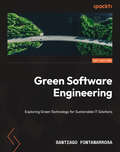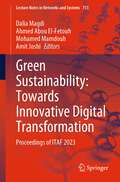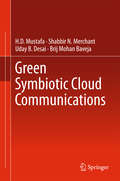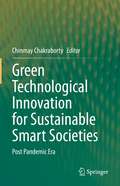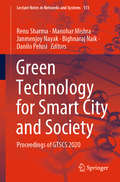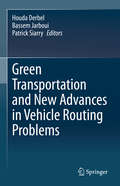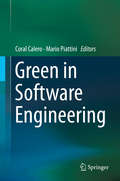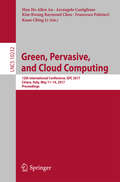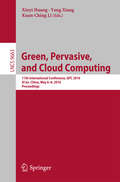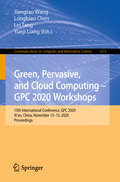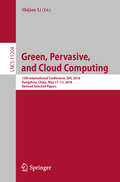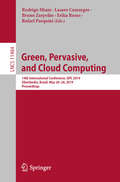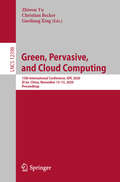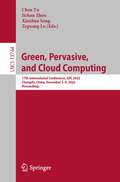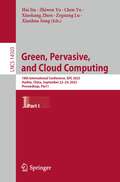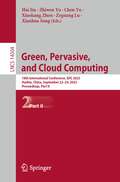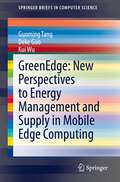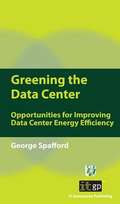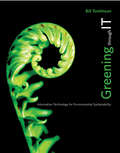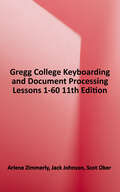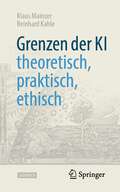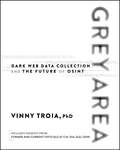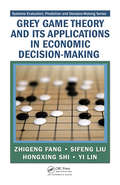- Table View
- List View
Green Project Management
by David Shirley Richard MaltzmanWinner of PMI's 2011 David I. Cleland Project Management Literature AwardDetailing cutting-edge green techniques and methods, this book teaches project managers how to maximize resources and get the most out of limited budgets. It supplies proven techniques and best practices in green project management, including risk and opportunity assessments.
Green Software Engineering: Exploring Green Technology for Sustainable IT Solutions
by Santiago FontanarrosaCraft sustainable software and reduce digital environmental impact with practical strategies and principles Key FeaturesDiscover practical strategies for developing energy-efficient digital solutions across various domainsLearn effective strategies to measure and mitigate the environmental impact of digital solutionsExplore real-world examples of integrating sustainable design patterns into the software development cyclePurchase of the print or Kindle book includes a free PDF eBookBook DescriptionEmbark on a transformative journey toward sustainable software engineering, exploring the vital intersection of technology and environmental responsibility. Authored by Santiago Fontanarrosa, a Green Software Foundation member with 20+ years in software engineering, this book explores practical strategies and use cases to help you assess and mitigate digital product environmental impact. Through real-world examples and hands-on experiences, you’ll gain the skills you need to craft environmentally responsible solutions aligned with green software engineering principles. As you progress, you’ll assess and optimize software architecture for sustainability within a sustainable software delivery framework schema. Beyond technical insights, the book delves into ethical implications and societal impacts, fostering a deeper understanding of the broader implications of technology usage. As you approach the conclusion, you’ll have gained the ability to comprehend, measure, and craft energy-efficient digital solutions aligned with green software engineering principles.What you will learnOptimize software and infrastructure for sustainabilityIntegrate green software principles into the Agile Software Development Life CycleExplore emerging trends and technologies shaping the future of green software engineeringReflect on tech ethics as well as address societal and environmental concernsImplement industry standards and reporting methodologies for software emissionsMeasure digital operations' environmental footprint with methodologiesMitigate software's ecological impact with strategic approachesWho this book is forIf you’re a software developer, software architect, or IT professional who wants to integrate sustainability into your organization, this book is for you. Whether you're a seasoned professional or a sustainability-focused tech enthusiast, this book provides the knowledge and tools you need to drive positive change in the software industry. A basic understanding of IT concepts and programming is recommended, and familiarity in modern digital technologies like cloud computing will also be helpful.
Green Sustainability: Proceedings of ITAF 2023 (Lecture Notes in Networks and Systems #753)
by Amit Joshi Mohamed Mamdouh Dalia Magdi Ahmed Abou El-FetouhThe book is a collection of best selected research papers presented at the Third World Conference on Internet of Things: Applications & Future (ITAF 2023) organized by Global Knowledge Research Foundation in Cairo during February 4–5, 2023. It includes innovative works from researchers, leading innovators, business executives, and industry professionals to examine the latest advances and applications for commercial and industrial end users across sectors within the emerging Internet of things ecosphere. It shares state-of-the-art as well as emerging topics related to Internet of things such as big data research, emerging services and analytics, Internet of things (IoT) fundamentals, electronic computation and analysis, big data for multi-discipline services, security, privacy and trust, IoT technologies, and open and cloud technologies.
Green Symbiotic Cloud Communications
by H. D. Mustafa Shabbir N. Merchant Uday B. Desai Brij Mohan BavejaThis book intends to change the perception of modern day telecommunications. Communication systems, usually perceived as "dumb pipes", carrying information / data from one point to another, are evolved into intelligently communicating smart systems. The book introduces a new field of cloud communications. The concept, theory, and architecture of this new field of cloud communications are discussed. The book lays down nine design postulates that form the basis of the development of a first of its kind cloud communication paradigm entitled Green Symbiotic Cloud Communications or GSCC. The proposed design postulates are formulated in a generic way to form the backbone for development of systems and technologies of the future. The book can be used to develop courses that serve as an essential part of graduate curriculum in computer science and electrical engineering. Such courses can be independent or part of high-level research courses. The book will also be of interest to a wide range of readers including both scientific and non-scientific domains as it discusses innovations from a simplistic explanatory viewpoint.
Green Technological Innovation for Sustainable Smart Societies: Post Pandemic Era
by Chinmay ChakrabortyThis book discusses the innovative and efficient technological solutions for sustainable smart societies in terms of alteration in industrial pollution levels, the effect of reduced carbon emissions, green power management, ecology, and biodiversity, the impact of minimal noise levels and air quality influences on human health. The book is focused on the smart society development using innovative low-cost advanced technology in different areas where the growth in employment and income are driven by public and private investment into such economic activities, infrastructure and assets that allow reduced carbon emissions and pollution, enhanced energy, and resource efficiency and prevention of the loss of biodiversity and ecosystem services. The book also covers the paradigm shift in the sustainable development for the green environment in the post-pandemic era. It emphasizes and facilitates a greater understanding of existing available research i.e., theoretical, methodological, well-established and validated empirical work, associated with the environmental and climate change aspects.
Green Technology for Smart City and Society: Proceedings of GTSCS 2020 (Lecture Notes in Networks and Systems #151)
by Janmenjoy Nayak Bighnaraj Naik Danilo Pelusi Renu Sharma Manohar MishraThis book includes selected papers from the International Conference on Green Technology for Smart City and Society (GTSCS 2020), organized by the Institute of Technical Education and Research, Siksha ‘O’ Anusandhan University, Bhubaneswar, India, during 13–14 August 2020. The book covers topics such as machine learning, artificial intelligence, deep learning, optimization algorithm, IoT, signal processing, etc. The book is helpful for researchers working in the discipline of Electrical, Electronics and Computer Science. The researchers working in the allied domain of communication and control will also find the book useful as it deals with the latest methodologies and applications.
Green Transportation and New Advances in Vehicle Routing Problems
by Patrick Siarry Bassem Jarboui Houda DerbelThis book presents recent work that analyzes general issues of green transportation. The contributed chapters consider environmental objectives in transportation, including topics such as battery swap stations for electric vehicles, efficient home healthcare routing, waste collection, and various vehicle routing problems. The content will be valuable for researchers and postgraduate students in computer science, operations research, and urban planning.
Green in Software Engineering
by Coral Calero Mario PiattiniThis is the first book that presents a comprehensive overview of sustainability aspects in software engineering. Its format follows the structure of the SWEBOK and covers the key areas involved in the incorporation of green aspects in software engineering, encompassing topics from requirement elicitation to quality assurance and maintenance, while also considering professional practices and economic aspects. The book consists of thirteen chapters, which are structured in five parts. First the "Introduction" gives an overview of the primary general concepts related to Green IT, discussing what Green in Software Engineering is and how it differs from Green by Software Engineering. Next "Environments, Processes and Construction" presents green software development environments, green software engineering processes and green software construction in general. The third part, "Economic and Other Qualities," details models for measuring how well software supports green software engineering techniques and for performing trade-off analyses between alternative green practices from an economic perspective. "Software Development Process" then details techniques for incorporating green aspects at various stages of software development, including requirements engineering, design, testing, and maintenance. In closing, "Practical Issues" addresses the repercussions of green software engineering on decision-making, stakeholder participation and innovation management. The audience for this book includes software engineering researchers in academia and industry seeking to understand the challenges and impact of green aspects in software engineering, as well as practitioners interested in learning about the state of the art in Green in Software Engineering.
Green, Pervasive, and Cloud Computing
by Kuan-Ching Li Man Ho Allen Au Arcangelo Castiglione Kim-Kwang Raymond Choo Francesco PalmieriThis book constitutes the proceedings of the 12th International Conference on Green, Pervasive, and Cloud Computing, GPC 2017, held in Cetara, Italy, in May 2017 and the following colocated workshops: First International Workshop on Digital Knowledge Ecosystems 2017; and First Workshop on Cloud Security Modeling, Monitoring and Management, CS3M 2017. The 58 full papers included in this volume were carefully reviewed and selected from 169 initial submissions. They deal with cryptography, security and biometric techniques; advances network services, algorithms and optimization; mobile and pervasive computing; cybersecurity; parallel and distributed computing; ontologies and smart applications; and healthcare support systems.
Green, Pervasive, and Cloud Computing
by Yang Xiang Xinyi Huang Kuan-Ching LiThis book constitutes the refereed proceedings of the 8th International Conference on Grid and Pervasive Computing, GPC 2013, held in Seoul, Korea, in May 2016. The 20 revised papers were carefully reviewed and selected from 94 submissions. The conference contains various aspects including green computing, cloud computing, virtualisation, data and storage, and network security.
Green, Pervasive, and Cloud Computing – GPC 2020 Workshops: 15th International Conference, GPC 2020, Xi'an, China, November 13–15, 2020, Proceedings (Communications in Computer and Information Science #1311)
by Jiangtao Wang Longbiao Chen Lei Tang Yunji LiangThis book constitutes the refereed proceedings of the Workshops from the 15th International Conference on Green, Pervasive, and Cloud Computing, GPC 2020, held in Xi'an, China, in November 2020. Due to the COVID-19 pandemic this event was held virtually.The 5 full papers presented in this book together with 3 short papers were carefully reviewed and selected from 16 submissions. They present recent research in the areas of urban computing, intelligent transportation and social computing.
Green, Pervasive, and Cloud Computing: 13th International Conference, GPC 2018, Hangzhou, China, May 11-13, 2018, Revised Selected Papers (Lecture Notes in Computer Science #11204)
by Shijian LiThis book constitutes the proceedings of the 13th International Conference on Green, Pervasive, and Cloud Computing, GPC 2018, held in Hangzhou, China, in May 2018.The 35 full papers included in this volume were carefully reviewed and selected from 101 initial submissions. They are organized in the following topical sections: network security, and privacy-preserving; pervasive sensing and analysis; cloud computing, mobile computing, and crowd sensing; social and urban computing; parallel and distributed systems, optimization; pervasive applications; and data mining and knowledge mining.
Green, Pervasive, and Cloud Computing: 14th International Conference, GPC 2019, Uberlândia, Brazil, May 26–28, 2019, Proceedings (Lecture Notes in Computer Science #11484)
by Rodrigo Miani Lasaro Camargos Bruno Zarpelão Erika Rosas Rafael PasquiniThis book constitutes the proceedings of the 14th International Conference on Green, Pervasive, and Cloud Computing, GPC 2019, held in Uberlândia, Brazil, in May 2019. The 17 full papers included in this volume were carefully reviewed and selected from 38 initial submissions. They are organized in the following topical sections: machine learning; Internet of Things and mobility; cloud and related technologies.
Green, Pervasive, and Cloud Computing: 15th International Conference, GPC 2020, Xi'an, China, November 13–15, 2020, Proceedings (Lecture Notes in Computer Science #12398)
by Christian Becker Zhiwen Yu Guoliang XingThis book constitutes the refereed proceedings of the 15th International Conference on Green, Pervasive, and Cloud Computing, GPC 2020, held in Xi'an, China, in November 2020. The 30 full papers presented in this book together with 8 short papers were carefully reviewed and selected from 96 submissions. They cover the following topics: Device-free Sensing; Machine Learning; Recommendation Systems; Urban Computing; Human Computer Interaction; Internet of Things and Edge Computing; Positioning; Applications of Computer Vision; CrowdSensing; and Cloud and Related Technologies.
Green, Pervasive, and Cloud Computing: 17th International Conference, GPC 2022, Chengdu, China, December 2–4, 2022, Proceedings (Lecture Notes in Computer Science #13744)
by Xianhua Song Zeguang Lu Chen Yu Jiehan ZhouThis book constitutes the refereed proceedings of the 17th International Conference on Green, Pervasive, and Cloud Computing, GPC 2022, held in Chengdu, China, in December 2022.The 19 full papers presented in this book were carefully reviewed and selected from 104 submissions. GPC 2022 shares novel ideas and experiences in the areas of Green, Pervasive, and Cloud Computing.
Green, Pervasive, and Cloud Computing: 18th International Conference, GPC 2023, Harbin, China, September 22–24, 2023, Proceedings, Part I (Lecture Notes in Computer Science #14503)
by Xianhua Song Zeguang Lu Hai Jin Chen Yu Zhiwen Yu Xiaokang ZhouThis book constitutes the refereed proceedings of the 18th International Conference on Green, Pervasive, and Cloud Computing, GPC 2023, held in Harbin, China, during September 23–24, 2023.The 38 full papers and 1 short paper included in this book were carefully reviewed and selected from 111 submissions. They were organized in topical sections as follows: Industrial Digitization and Applications, Edge Intelligence, Mobile Sensing and Computing, Cyber-Physical-Social Systems, Pervasive and Green Computing and Wireless and Ubiquitous Networking.
Green, Pervasive, and Cloud Computing: 18th International Conference, GPC 2023, Harbin, China, September 22–24, 2023, Proceedings; Part II (Lecture Notes in Computer Science #14504)
by Xianhua Song Zeguang Lu Hai Jin Chen Yu Zhiwen Yu Xiaokang ZhouThis book constitutes the refereed proceedings of the 18th International Conference on Green, Pervasive, and Cloud Computing, GPC 2023, held in Harbin, China, during September 23–24, 2023.The 38 full papers and 1 short paper included in this book were carefully reviewed and selected from 111 submissions. They were organized in topical sections as follows: Industrial Digitization and Applications, Edge Intelligence, Mobile Sensing and Computing, Cyber-Physical-Social Systems, Pervasive and Green Computing and Wireless and Ubiquitous Networking.
GreenEdge: New Perspectives to Energy Management and Supply in Mobile Edge Computing (SpringerBriefs in Computer Science)
by Guoming Tang Deke Guo Kui WuThe 5G technology has been commercialized worldwide and is expected to provide superior performance with enhanced mobile broadband, ultra-low latency transmission, and massive IoT connections. Meanwhile, the edge computing paradigm gets popular to provide distributed computing and storage resources in proximity to the users. As edge services and applications prosper, 5G and edge computing will be tightly coupled and continuously promote each other forward. Embracing this trend, however, mobile users, infrastructure providers, and service providers are all faced with the energy dilemma. On the user side, battery-powered mobile devices are much constrained by battery life, whereas mobile platforms and apps nowadays are usually power-hungry. At the infrastructure and service provider side, the energy cost of edge facilities accounts for a large proportion of operating expenses and has become a huge burden. This book provides a collection of most recent attempts to tackle the energy issues in mobile edge computing from new and promising perspectives. For example, the book investigates the pervasive low-battery anxiety among modern mobile users and quantifies the anxiety degree and likely behavior concerning the battery status. Based on the quantified model, a low-power video streaming solution is developed accordingly to save mobile devices' energy and alleviate users' low-battery anxiety. In addition to energy management for mobile users, the book also looks into potential opportunities to energy cost saving and carbon emission reduction at edge facilities, particularly the 5G base stations and geo-distributed edge datacenters.
Greening the Data Center: Opportunities for Improving Data Center Energy Efficiency
by George SpaffordIT organizations are under intense pressure to manage the power consumed by data centers and the resulting cooling demands. To address these needs, IT needs to properly blend people, process and technology to create solutions. In my first Green IT pocket guide, we reviewed governance and processes for Green IT. In this guide we will provide a sample of technical improvement opportunities at a high-level. By doing so, the intent is to foster discussions in your own organization around what should be done first, second, third and so on. The result of this should be a technical implementation roadmap that supports the objectives of Green IT. Indeed, most data centers will not suffer from a lack of opportunities to improve. What is needed is careful planning and deliberate execution to manage power and cooling while continuing to create and protect value for the organization.
Greening through IT: Information Technology for Environmental Sustainability (The\mit Press Ser.)
by Bill TomlinsonHow the tools of information technology can support environmental sustainability by tackling problems that span broad scales of time, space, and complexity.Environmental issues often span long periods of time, far-flung areas, and labyrinthine layers of complexity. In Greening through IT, Bill Tomlinson investigates how the tools and techniques of information technology (IT) can help us tackle environmental problems at such vast scales. Tomlinson describes theoretical, technological, and social aspects of a growing interdisciplinary approach to sustainability, “Green IT,” offering both a human-centered framework for understanding Green IT systems and specific examples and case studies of Green IT in action.Tomlinson descrobes many efforts toward sustainability supported by IT—from fishers in India who maximized the sales potential of their catch by coordinating their activities with mobile phones to the installation of smart meters that optimize electricity use in California households—and offers three detailed studies of specific research projects that he and his colleagues have undertaken: EcoRaft, an interactive museum exhibit to help children learn principles of restoration ecology; Trackulous, a set of web-based tools with which people can chart their own environmental behavior; and GreenScanner, an online system that provides access to environmental-impact reports about consumer products. Taken together, these examples illustrate the significant environmental benefits that innovations in information technology can enable.
Gregg College Keyboarding & Document Processing Lessons 1-60 11th Edition
by Scot Ober Arlene Zimmerly Jack JohnsonGDP/11 is an integrated keyboarding system designed to process and score documents created in Microsoft Word. Together, this book and software systematically lead students through each lesson to provide an easy path to success.
Gregg College Keyboarding and Document Processing for Windows: Lessons 1-60
by Scot OberThis book is a multi component instructional program designed to give the student and the instructor a high degree of flexibility and a high degree of success in meeting their respective goals.
Grenzen der KI – theoretisch, praktisch, ethisch (Technik im Fokus)
by Klaus Mainzer Reinhard KahleKünstliche Intelligenz ist eine Schlüsseltechnologie, mit der sowohl in der Wissenschaft als auch in der Industrie große Erwartungen verbunden sind. In diesem Buch werden sowohl die Perspektiven als auch die Grenzen dieser Technologie diskutiert. Das betrifft die praktischen, theoretischen und konzeptionellen Herausforderungen, denen sich die KI stellen muss. In einer Frühphase standen in der KI Expertensysteme im Vordergrund, bei denen mit Hilfe symbolischer Datenverarbeitung regelbasiertes Wissen verarbeitet wurde. Heute wird die KI von statistik-basierten Methoden im Bereich des maschinellen Lernens beherrscht. Diese subsymbolische KI wird an den Lehren, die aus der Frühphase der KI gezogen werden können, gemessen. Als Ergebnis wird vor allem für eine hybride KI argumentiert, die die Potentiale beider Ansätze zur Entfaltung bringen kann.
Grey Area: Dark Web Data Collection and the Future of OSINT
by Vinny TroiaA compelling, first-hand account of the dark web, from its underground ecosystem, to the people responsible for committing data breaches and leaking data, 21st century's most consequential data breaches, the responses to those attacks, and the impact of dark web data and intelligence gathering and can have in the defense and security of our nation. In Grey Area, veteran hacker and cybersecurity investigations expert Vinny Troia offers an unfiltered, first-person look into the evolving relationship between open-source intelligence (OSINT) and the dark web data ecosystem. Drawing from years of hands-on experience in digital forensics, dark web investigations, and adversarial engagement, Troia explores how publicly available and commercially available information—PAI and CAI—are rapidly becoming the backbone of modern intelligence operations, and how a human intelligence network of known cyber criminals helped identify and stop one of the largest data breaches in known history. This book examines the legal, operational, and ethical dimensions of collecting and exploiting data from the darkest corners of the internet, including leaked databases, breached credentials, and hidden criminal networks. It breaks down how to discover, process, validate, and operationalize this data in real-world contexts—from attribution and threat actor profiling to national security use cases. You'll explore the evolution of OSINT within the Department of Defense and the Intelligence Community through exclusive, first-hand accounts from senior officials who helped define its path. You'll also learn how AI and automation tools are being used to validate data at scale, detect disinformation, and supercharge open-source investigations. The book also covers how data is stolen and what happens to it after the theft. Through his direct account as Reddington, Troia provides actual unedited conversations with the cyber criminals responsible for a hack targeting more than 160 companies, including his own interactions leading to the hack, the extortion negotiation and responses with each of the effected organizations, and how the hackers were ultimately brought to justice. From discussions of the legal grey areas of data collection, ransom negotiations, and a first-hand perspectives of his interaction with well-known hackers, Grey Area is a compelling and honest account of the realities of the dark web, data theft, and ways in which the intelligence community should be leveraging these methods to help strengthen our national security. Inside the book: Blow-by-blow accounts of one of the largest data breaches in recorded history Interviews and commentary from high level officials at the CIA, ODNI, DIA, and DOD. Informed, insightful commentary on how cybersecurity professionals are using dark web open-source intelligence to strengthen national security, and our country's defenses against hackers and foreign adversaries. Revealing interviews with experienced hackers who explain a variety of approaches, philosophies, and strategies for combatting and recovering from data breaches Grey Area is essential reading for cybersecurity professionals, intelligence analysts, investigators, and policy leaders navigating the complex intersection of dark web data, national security, and open-source intelligence. Through real-world case studies and insider accounts, it delivers actionable insight into the future of data-driven investigations, threat attribution, and the expanding role of OSINT in modern intelligence operations.
Grey Game Theory and Its Applications in Economic Decision-Making (Systems Evaluation, Prediction, and Decision-Making)
by Yi Lin Sifeng Liu Zhigeng Fang Hongxing ShiTo make the best decisions, you need the best information. However, because most issues in game theory are grey, nearly all recent research has been carried out using a simplified method that considers grey systems as white ones. This often results in a forecasting function that is far from satisfactory when applied to many real situations. Grey Ga

